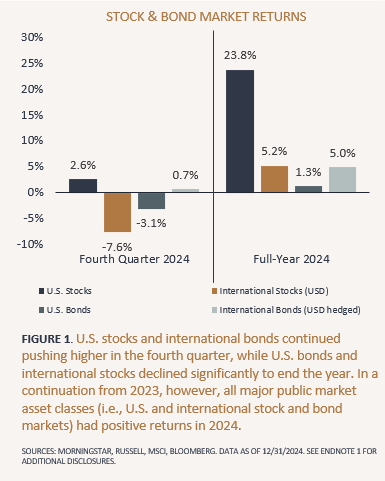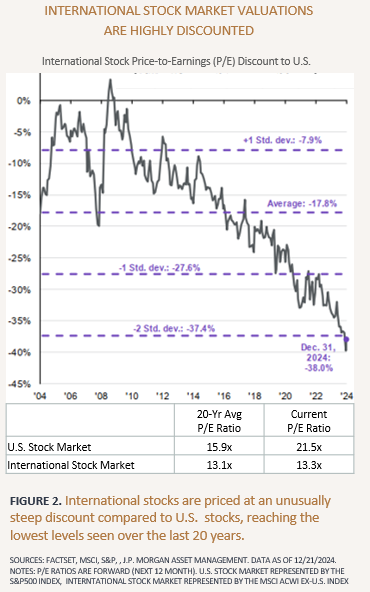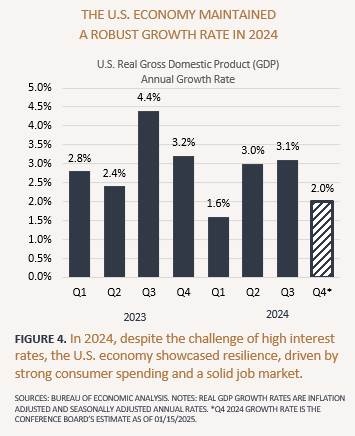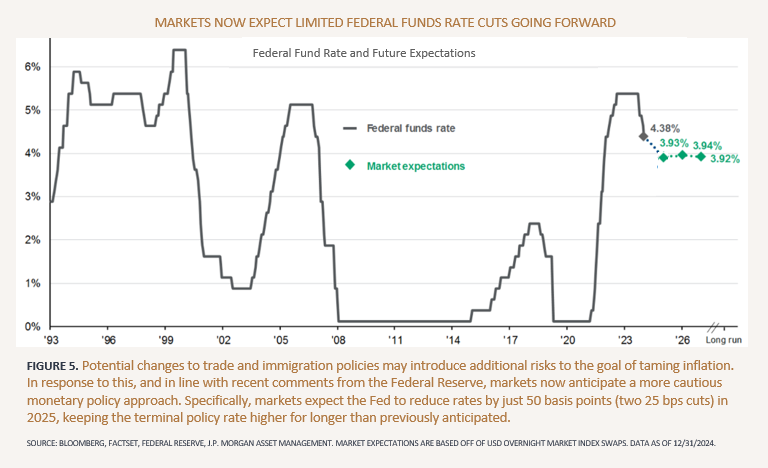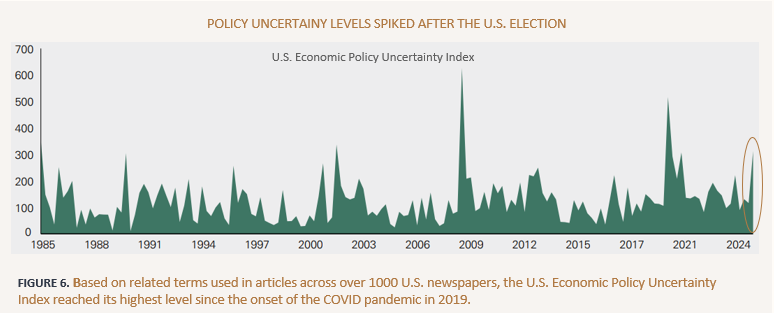Trump’s Policy Shake-Up – What it Could Mean for the Market and Economy

KEY POINTS
Stock and bond markets delivered positive returns in 2024, with U.S. stocks again leading the way as markets navigated shifting central bank policies and an evolving political landscape. Looking ahead, we discuss why stock market gains could continue with potentially more downside volatility along the way and why bond market returns will likely improve in 2025.
The U.S. economy closed the year on a resilient note, with GDP growth exceeding expectations in 2024 while economic conditions abroad remained uneven. Our outlook discusses why the U.S. economy will likely grow at a moderate pace in 2025 and why international growth prospects this year are likely to vary significantly across regions.
President Donald Trump has promised significant shifts with proposals such as corporate tax cuts, government spending cuts, and changes to trade and immigration policy. We assess the potential market and economic impacts of the new administration’s ambitious economic agenda.
Finally, we discuss how to strategically position portfolios amid higher bond market yields and risks of persistent above-target inflation and high U.S. stock market valuations. We also highlight ideas to further enhance portfolio diversification and help improve long-term risk-adjusted returns.
VIEW A SHORT SUMMARY VIDEO
MARKET REVIEW
U.S. STOCKS SHINED IN 2024 AS INTERNATIONAL MARKETS NAVIGATED CHALLENGES
Global stock markets closed out 2024 with mixed results in the fourth quarter, marked by gains in the U.S. and significant declines abroad. (See Figure 1.) U.S. stock markets, buoyed by solid corporate earnings, moderating inflation, and optimism around AI-driven innovation, extended their rally despite some late-year volatility. In contrast, international stock markets struggled to keep pace, hindered by weaker growth in Europe and China, geopolitical tensions, an appreciating U.S. dollar, and uncertainty surrounding potential new tariffs following the U.S. election. Broadly, the year was shaped by central banks' shifting monetary policies, with U.S. rate cuts supporting a still-resilient economy and providing a tailwind for domestic markets, while rate cuts abroad often reflected declining or anemic growth, tempering investor enthusiasm.
INTERNATIONAL BONDS OUTPERFORMED U.S. BONDS AMID GLOBAL RATE CUTS
Global bond markets faced an eventful 2024, with varied performance across U.S. and international markets. In the U.S., higher starting yields helped provide income for bond investors, but this was largely offset by rising long-term yields and renewed concerns about inflation, which weighed down intermediate and long-term bonds. The Federal Reserve continued reducing its policy interest rate in the fourth quarter, but its signals of a less accommodative stance moving forward negatively impacted U.S. bond market performance. In contrast, international bond markets outperformed the U.S., as rate cuts abroad were accompanied by declining inflation and weaker economic growth expectations, creating a more favorable environment for international bond investors.
MARKET OUTLOOK
STOCKS POISED FOR GAINS IN 2025 DESPITE GLOBAL UNCERTAINTIES
Stock markets enter 2025 against a cautiously optimistic backdrop. U.S. stocks are poised to build on their recent momentum, supported by a resilient domestic economy and inflation that remains somewhat elevated but stable. While U.S. stock market valuations are high by historical standards, robust corporate earnings growth and sustained investment in transformative technologies like AI could lay the groundwork for further gains.
That said, heightened uncertainty around trade policy, government spending, geopolitical tensions, and the risk of renewed inflationary pressures may lead to bouts of downside volatility. Elevated valuations and high investor expectations increase the likelihood of market corrections, but a favorable macroeconomic and financial environment—including steady economic growth and potentially supportive monetary and tax policy—should ultimately enable U.S. stocks to deliver positive returns in 2025.
International stock markets face a more nuanced outlook, shaped by uneven economic growth, structural challenges in key regions, and uncertainty in global trade. European markets may struggle with subdued growth and manufacturing headwinds, while policy shifts in Asia, particularly in China, aim to stabilize demand amid tariff pressures and lingering property market weaknesses. Latin American markets face their own challenges, with heightened sensitivity to shifts in global trade policies and tariff uncertainty adding pressure to the region’s export-driven economies.
Despite these challenges, easing global inflation and renewed monetary policy support could help mitigate downside risks for international stocks. Moreover, exceptionally attractive stock valuations relative to historical and U.S. market levels (see Figure 2), coupled with the potential for a stabilizing or weakening U.S. dollar, could support positive returns for international stocks, underscoring the importance of global stock diversification in 2025.
BONDS ENTER 2025 WITH HIGHER YIELDS AND A PROMISING OUTLOOK
The bond market enters 2025 on solid footing, with elevated starting yields offering a compelling income opportunity for bond investors. (See Figure 3.) In the U.S., the Federal Reserve's gradual shift toward an accommodative policy could help stabilize longer-term rates, further strengthening the outlook for bonds. While U.S. bond returns were negatively impacted in 2024 by rising long-term rates driven by higher growth and inflation expectations, these same dynamics now set the stage for improved returns. Moreover, renewed inflationary pressures or stronger-than-expected economic growth could keep rates elevated, limiting capital gains in bonds but maintaining a favorable yield environment for longer. Overall, U.S. bonds are well-positioned to contribute positively to portfolio performance.
Internationally, bond markets are poised to benefit from easing monetary policies and relatively lower inflation, particularly in Europe and Asia. Globally, easing inflation and ongoing central bank rate cuts are expected to support international bond values, especially in regions where economic growth remains subdued. Across global markets, bonds remain an appealing choice for income generation and risk mitigation, providing resilience amid potential economic and market uncertainties in 2025.
ECONOMIC REVEW
U.S. ECONOMY SUSTAINED STRONG GROWTH TO END 2024
The U.S. economy closed the year on a resilient note, with GDP growth exceeding expectations in 2024 despite earlier concerns of a slowdown. (See Figure 4.) Consumer spending remained a key driver, supported by a strong labor market and rising wages, while businesses significantly increased investment in technology and infrastructure, particularly in AI and automation. Inflation showed signs of stabilization, remaining above the Federal Reserve’s target but significantly below the post-pandemic highs. In September, the Federal Reserve began lowering rates in response to softening in the labor market and easing inflationary pressures. By November and December, the Fed signaled a more cautious approach to further cuts, emphasizing the need to balance economic growth against lingering inflation risks.
INTERNATIONAL ECONOMIES SHOWED MIXED PROGRESS AMID PERSISTENT CHALLENGES
Economic conditions abroad remained uneven in 2024, with developed and emerging markets facing divergent challenges. In Europe, economic activity was constrained by subdued manufacturing output, tepid consumer demand, and the lingering effects of energy market disruptions earlier in the year. However, inflation moderated closer to the European Central Bank’s target, and ongoing monetary easing provided a foundation for potential recovery. Coordinated fiscal policies across the Eurozone offered additional support, although growth remained sluggish. The United Kingdom faced similar headwinds, with high borrowing costs and softening consumer confidence weighing on overall activity, though labor markets showed surprising resilience.
Asia presented a mixed picture, with China struggling to regain momentum despite fiscal stimulus measures and policy adjustments. Ongoing weakness in the property sector and subdued business sentiment hindered growth, but modest improvements in export activity and targeted government support offered glimmers of recovery late in the year. Meanwhile, Southeast Asian economies demonstrated relative resilience, supported by diversified trade partnerships and robust consumer demand. Japan, by contrast, experienced modest expansion, supported by strong consumer spending and an accommodative monetary stance, while gradually improving supply chains bolstered production in key industries.
ECONOMIC OUTLOOK
STEADY ECONOMIC GROWTH IN THE U.S. AMID POLICY UNCERTAINTY
The U.S. economy will likely grow at a moderate pace in 2025, supported by resilient consumer spending and business investment.
Real gross domestic product (GDP) growth is projected to grow between 2%-2.5%,³ with the labor market remaining healthy despite a gradual slowdown in job creation. Inflation is expected to decline gradually but may stabilize slightly above the Federal Reserve’s 2.0% target. Potential policy shifts under the new administration introduce uncertainty around inflation, likely prompting the Fed to slow the pace of rate cuts. (See Figure 5.) Proposed tax cuts and deregulation measures could further influence growth dynamics and bolster corporate profitability.
Overall, the U.S. economy appears positioned for steady, albeit cautious, progress amid evolving policy and geopolitical changes.
ECONOMIC GROWTH ABROAD FACES DIVERGENT PATHS AND NEW CHALLENGES
International growth prospects for 2025 are likely to vary significantly across regions.
Europe will likely contend with subdued growth amid manufacturing headwinds and potential trade conflicts with the U.S., though aggressive monetary easing by the European Central Bank may provide some support. Asia’s outlook appears mixed; while China faces slowing domestic demand and external pressures, it will likely need to implement additional fiscal stimulus to stabilize growth and navigate potential new tariffs. Meanwhile, Japan and Southeast Asia could benefit from resilient consumer spending and supply chain diversification efforts. Latin America’s export-driven economies remain sensitive to global trade dynamics but may find relief in stabilizing commodity prices and easing inflation.
Across regions, geopolitical tensions and shifts in trade policies will shape economic trajectories in 2025.
ON THE MINDS OF INVESTORS
TRUMP’S POLICY SHAKE-UP – WHAT IT COULD MEAN FOR THE MARKET AND ECONOMY
Following President Donald Trump's inauguration, investors will closely monitor the potential market and economic impacts of his administration's policies.
The new administration's agenda promises significant shifts, with proposals such as corporate tax cuts, government spending cuts, and changes to trade and immigration policy. While these initiatives aim to stimulate economic growth and enhance U.S. competitiveness, markets have thus far had mixed reactions, given the high uncertainty surrounding new policy implementation and potential impacts. (See Figure 6.)
One of the cornerstone proposals is an extension of the Tax Cuts and Jobs Act and additional tax cuts, including potentially lowering the corporate tax rate broadly from 20% to 15%. A significant and broad-based corporate tax cut like this would bolster corporate profitability and likely encourage domestic investment, particularly in the manufacturing and technology sectors. However, the impact on federal deficits remains a concern. Moreover, slim Republican majorities in Congress may limit the extent of these tax policy changes, as political opposition and budgetary constraints could delay and complicate the passage of certain measures. In the end, additional tax cuts beyond extending current tax breaks will likely be modest.
The new administration has proposed significant cuts to government spending, with stated ranges targeting reductions of up to 10-15% in certain federal programs. While these proposals aim to address budgetary concerns and reduce deficits, the likelihood of enacting cuts large enough to materially impact the economy is low. Political resistance, the complexity of federal budgets, and the need to fund key priorities (such as defense and entitlement programs) make sweeping reductions challenging. As a result, while these proposals may influence specific sectors or programs, their broader economic impact is likely to be limited.
The administration's trade policy agenda, including the possibility of new tariffs on imports, particularly from China, introduces another layer of complexity. The implementation of universal tariffs could result in higher consumer prices and strained relations with key trading partners. Though certain sectors, such as domestic manufacturing, may benefit from greater protection, the potential for retaliatory tariffs poses risks to export-driven industries. The likely outcome is that tariff threats will be used as leverage in trade negotiations, and any new tariffs implemented will probably be modest and targeted, resulting in a negligible short-lived impact on inflation.
On immigration, proposals to limit workforce inflows could constrain labor market growth and exacerbate wage pressures. While this may support higher consumer incomes, it could also challenge industries reliant on a robust labor supply, particularly agriculture and construction. With that said, the likely outcome is that net immigration is likely to decline somewhat from current levels but not go to zero or a negative level. As such, changes to immigration are likely to have a gradual and marginal impact on inflation and economic growth.
Despite all these policy uncertainties, the overall outlook for investors remains cautiously optimistic. If implemented gradually and thoughtfully, many of these policy changes could create a favorable environment for corporate earnings and economic growth. However, risks surrounding legislative hurdles and potential policy missteps could temper the effectiveness of these initiatives or negatively impact growth and inflation. Either way, the long-term growth trajectory of the U.S. economy will not substantially change.
PORTFOLIO MANAGEMENT
Our portfolio positioning and management recommendations are informed by current market and economic conditions coupled with a long-term investment view. Our views consider the current higher yields on bonds and the potential for further stock market gains amid continued positive corporate earnings growth. This is balanced with the risks of continued above-target inflation and high U.S. stock market valuations (and concentration) leading to increasing market volatility.
TAKE THE OPPORTUNITY TO REBALANCE
Stock market rallies, like the one we have experienced over the last two-plus years, present opportunities for long-term investors to take some gains off the table by selling some higher-priced assets (mainly U.S. stocks) and add to other asset classes (like bonds and international stocks) that have more favorable valuations. Rebalancing is something we recommend and proactively do for clients to the extent that it brings a portfolio’s asset mix back in line with strategic targets. Rebalancing keeps a portfolio’s current risk level in check and helps improve portfolio risk-adjusted returns over the long term.
MAINTAIN BROAD DIVERSIFICATION WITHIN STOCK ALLOCATIONS
Despite the significant contribution to stock market gains from U.S. mega-cap technology growth stocks in recent years, we recommend that investors diversify their stock allocations across various sectors, company sizes, styles, and countries. Broadening out one’s stock exposure helps to protect a portfolio from concentration risk, that is, the risk that the few stocks that have rallied the most (and hence may be more expensive) eventually go through a long, difficult stretch. Spreading out stock exposures also enables portfolios to benefit from further market gains when market performance eventually broadens out.
(RE)ALLOCATE TO HIGH-QUALITY, INTERMEDIATE-TERM BONDS
We recommend that investors strategically allocate to (and replenish to target) high-quality, intermediate-term bonds. This positioning will benefit portfolios given the current higher yields in longer-term bonds mentioned earlier, and the eventual scenario of more challenging economic conditions down the road. Should the economy start to slow, bonds issued by companies, governments, and municipalities with a lower probability of default should hold up well and act as an effective diversifier against periodic stock market declines. Moreover, as the Fed continues lowering interest rates, yields on cash, treasury bills, money market funds, and other short-term securities will also decline and no longer provide a yield advantage over bonds.
CONSIDER WAYS TO FURTHER DIVERSIFY TO IMPROVE LONG-TERM OUTCOMES
As part of our commitment to helping clients achieve their long-term financial goals, we continually evaluate ways to enhance portfolio diversification and improve risk-adjusted returns. For clients who meet certain requirements and can tolerate some degree of illiquidity, incorporating private market investments may provide a compelling opportunity to further diversify portfolios. These private market asset classes, including private equity, private credit, and private real assets such as real estate and infrastructure, represent an extension of the equity (stock), debt (bond), and real asset (real estate and infrastructure) investments we already recommend in public markets.
Private market investments have the potential to offer benefits such as higher returns, lower volatility, lower correlations with traditional asset classes, and unique opportunities to invest in industries, companies, or assets not available in public markets. For suitable investors, thoughtfully allocating to these private market strategies can complement existing portfolios, helping to lower risk and improve long-term outcomes. While these opportunities require careful consideration and a disciplined approach, they align with our philosophy of maintaining diversified, resilient portfolios designed to thrive across varying market environments.
As we gradually introduce these opportunities, we remain focused on ensuring that any recommendations align with each client’s unique financial circumstances, goals, and risk tolerance. By staying committed to long-term portfolio discipline and embracing new ways to diversify, we believe clients can position themselves for continued success over time.
SOURCES & ENDNOTES
¹ Notes: U.S. Stock returns are represented by the Russell 3000 Index Total Return (TR) USD. International Stock returns are represented by the MSCI All-Country-World Ex-USA Investible Market Index (IMI) Gross Return (GR) USD. U.S. Bond returns are represented by the Bloomberg Aggregate Bond Index Total Return (TR) USD. International Bond returns are represented by the Bloomberg Global Aggregate Ex-USA Dollar-Hedged Index Total Return (TR) USD.
² Municipal Bonds are represented by the Bloomberg Municipal Index, Corporate Bonds are represented by The Bloomberg U.S. Corporate Index, Asset Backed Securities are represented by the Bloomberg U.S. ABS Index, Mortgage-Backed Securities are represented by the Bloomberg U.S. MBS Index, Total Bond Market is represented by the Bloomberg U.S. Aggregate Bond Index, and Treasuries are represented by the Bloomberg U.S. Treasury Index.
³ As of 01/15/2025, the Conference Board forecasts U.S. real GDP growth of 2.3% in 2025.
Past performance does not guarantee future results. Indices are not available for direct investment; therefore, their performance does not reflect the expenses associated with the management of an actual portfolio.
IMPORTANT DISCLOSURE INFORMATION
Please remember that different types of investments involve varying degrees of risk, including the loss of money invested. Past performance may not be indicative of future results. Therefore, it should not be assumed that future performance of any specific investment or investment strategy, including the investments or investment strategies recommended or undertaken by Capstone Financial Advisors, Inc. (“Capstone”) will be profitable. Definitions of any indices listed herein are available upon request. Please contact Capstone if there are any changes in your personal or financial situation or investment objectives for the purpose of reviewing our previous recommendations and services, or if you wish to impose, add, or modify any reasonable restrictions to our investment management services. This article is not a substitute for personalized advice from Capstone and nothing contained in this presentation is intended to constitute legal, tax, accounting, securities, or investment advice, nor an opinion regarding the appropriateness of any investment, nor a solicitation of any type. Investment decisions should always be based on the investor’s specific financial needs, objectives, goals, time horizon, and risk tolerance. This article is current only as of the date on which it was sent. The statements and opinions expressed are, however, subject to change without notice based on market and other conditions and may differ from opinions expressed by other businesses and activities of Capstone. Descriptions of Capstone’s process and strategies are based on general practice, and we may make exceptions in specific cases. A copy of our current written disclosure statement discussing our advisory services and fees is available for your review by contacting us at capstonefinancialadvisors@capstone-advisors.com or (630) 241-0833.


